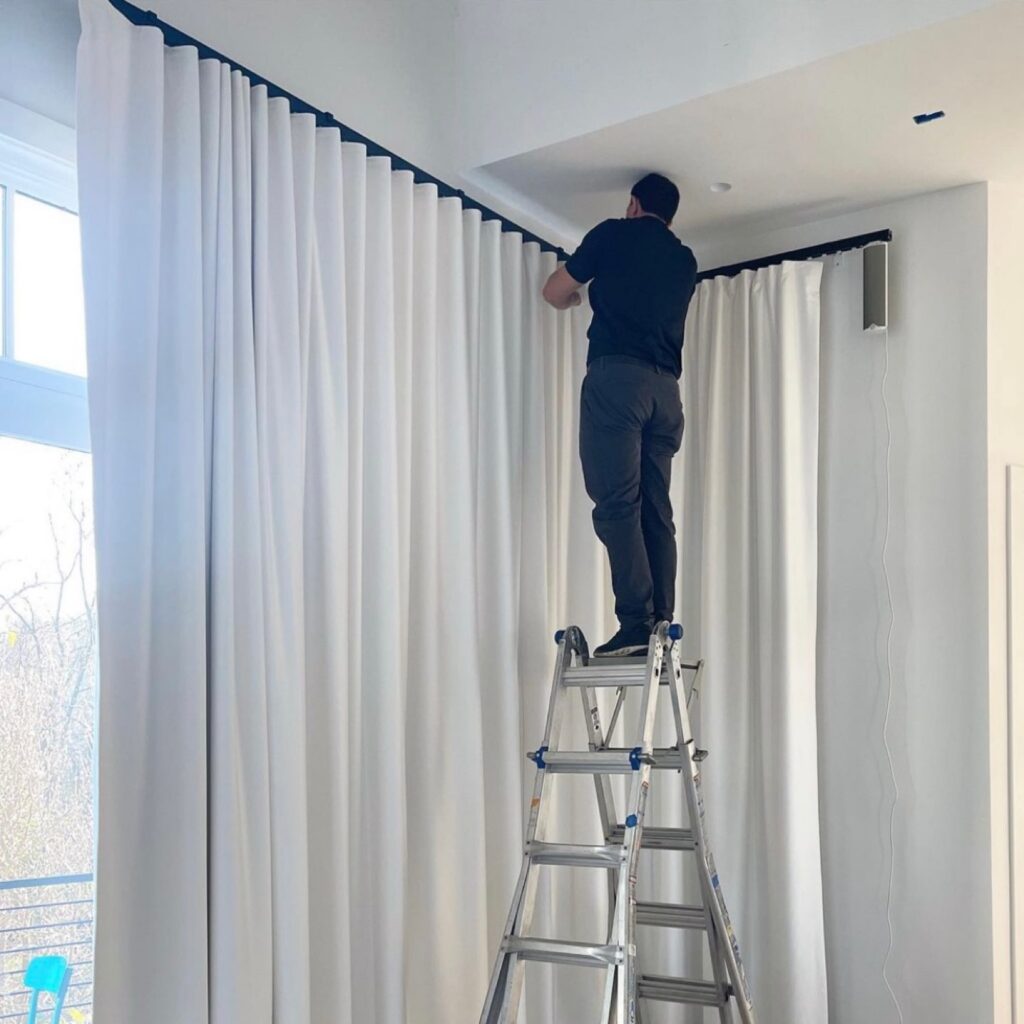Table of Contents

Key Takeaways
- Drapes are heavy fabric panels used for blocking light and providing insulation, distinct from lighter curtains.
- Drapes should touch the floor for a classic look or slightly puddle for an elegant effect. Therefore, there’s no uniform length drapes should be.
- Drape styles include rod pocket, tab top, grommet, and pleated, each suitable for different decor aesthetics from casual to formal.
- A window treatment designer can be invaluable in selecting and installing the perfect drapes for your space.
Introduction
If you’re looking to add an elegant touch to your space, drapes are a great choice. These window treatments not only provide privacy and light control but also enhance the overall aesthetic of a room. However, when it comes to drapes, one crucial aspect to consider is their length. Getting the right drape length is essential to achieve the perfect fit and create a visually pleasing look. In this post, we will guide you on how to determine the ideal drape length for your windows.
What are Drapes?
Before we dive into drape length, let’s first understand what drapes actually are. Drapes are fabric panels that hang from a rod or pole and cover windows. They are typically made from heavier materials such as velvet, silk, or linen, which not only block light but also provide insulation. This is precisely what differentiates drapes from curtains as the two treatments are often confused for one another. In contrast to drapes, curtains are typically made from lighter materials with the intention of filtering out light rather than completely blocking it.
Historically, drapes have been used not only for their practical purposes but also for their aesthetic value. In ancient civilizations, such as the Egyptians and Greeks, drapes were often made from luxurious materials like silk and adorned with intricate patterns or embroidery to signify wealth and status. These decorative elements added a touch of elegance to the interiors of palaces and temples, showcasing the craftsmanship and artistry of the time. Not to mention, drapes offered insulation amidst the warmer climates those ancient civilizations were located in.
Beyond the ancient Egyptians and Greeks, drapes have evolved over the centuries to become a versatile design element in interior decor. From traditional styles with ornate tassels and valances to modern minimalistic designs, drapes can dramatically transform the ambiance of a room. The choice of fabric, color, and length can all play a significant role in setting the tone of a space, whether it be cozy and intimate or bright and airy. By carefully selecting the right drapes, you can enhance the overall aesthetic appeal of your home while also enjoying the functional benefits they provide.
Now that the timelessness of drapes has been established, plus the fact that they’ve long been trusted as a tried and true option for treating windows, the next question that often arises is how long should your drapes be?
How Long Should Drapes Be?
The ideal length of drapes depends on the desired look and function. For a classic look, drapes should just touch the floor. For a more dramatic, elegant effect, they can extend an inch or two onto the floor, creating a slight break or puddle. If you want to avoid any interference with cleaning, opt for drapes that hang about half an inch above the floor. In spaces where frequent opening and closing occur, such as in kitchens, consider shorter drapes that end at the windowsill or just below.
Should Drapes Touch the Floor?
Whether drapes should touch the floor depends on your personal style and functional needs. For a clean and tailored appearance, drapes can just touch the floor. If a more luxurious or dramatic look is desired, allowing them to extend slightly onto the floor can create an elegant puddle. Alternatively, for practical reasons such as ease of cleaning and avoiding wear in high-traffic areas, it might be preferable to have drapes that hover just above the floor.
How Far Should Drapes Extend?
Drapes should extend approximately six to eight inches beyond either side of the window frame. This ensures adequate coverage and allows for maximum light control and privacy when the drapes are closed. Additionally, extending drapes beyond the window frame makes the window appear larger and allows more natural light to enter the room when the drapes are open. The width of the drapery rod should also be considered to ensure it supports this extension adequately.
What are the Different Styles of Drapes?
Now that we have covered the importance of drape length, let’s explore the various styles of drapes available. Understanding the different styles allows you to choose the one that best compliments your space and aligns with your personal taste.
- Rod Pocket Drapes: These drapes feature a pocket along the top where the rod passes through. They create gathered folds and have a casual and relaxed appearance. Rod pocket drapes are versatile and can be used in various settings.
- Tab Top Drapes: With fabric loops or tabs sewn along the top, these drapes are hung from the rod by simply sliding it through the tabs. Tab top drapes offer a more contemporary look and are ideal for casual and informal spaces.
- Grommet Drapes: Grommet drapes have metal rings along the top through which the rod is threaded. They provide a clean and modern aesthetic and allow for easy opening and closing. Grommet drapes work well in contemporary and minimalist interiors.
- Pleated Drapes: Pleated drapes feature tailored folds and offer a more formal and sophisticated look. They add an element of elegance and are suitable for classic and traditional spaces. There are various pleat styles to choose from, including pinch pleat, goblet pleat, and inverted pleat.
Which Drapery Style is Best for You?
Choosing the right drapery style can be a daunting task. To determine the best style for you, consider the overall decor and theme of your room, as well as your personal preferences. Take into account the formality or informality you want to achieve and whether you desire a traditional or contemporary look.
It’s also crucial to consider the fabric choice and how it complements the chosen style. Heavier fabrics like velvet add richness and opulence, while lighter fabrics like linen lend an airy and relaxed feel.
All in all, experimenting with different drapery styles and fabrics can help you find the perfect fit for your space. However, if you don’t even want to go as far as experimentation, you can always opt to seek the help and guidance of a professional window treatment designer.
What are some Alternatives to Drapes?
Drapes may not be the ideal window treatment for everyone. If you’re seeking alternatives, here are a few options to consider:
- Blinds: Blinds are a practical and versatile option. They come in various materials like wood, faux wood, and aluminum, offering different levels of privacy and light control.
- Shades: Shades are available in a wide range of styles, including roller shades, Roman shades, and cellular shades. They are sleek and offer an uncluttered appearance.
- Shutters: Shutters provide a classic and timeless look. They are available in different materials like wood, composite, and vinyl, allowing you to choose the one that suits your needs.
By exploring these alternatives, you can find a window treatment that fits your style, preferences, and functional requirements.
Are Window Treatment Designers Necessary?
As posed earlier, choosing the right drapery style according to your space can be daunting. Moreover, when it comes to the installation of your chosen drapes, and ensuring the correct fit, you may be left feeling overwhelmed.
In such a scenario, a window treatment designer is absolutely necessary. That is, unless you are determined to take on drapery selection and installation completely on your own.
With a window treatment designer, you can rely on their design expertise and experience to guide you through the drapery selection process. For example, during the initial stages of working with a window treatment designer, you may have a rough vision of what you’re trying to achieve alongside which particular drapes you are seeking to install. With that rough idea in mind, a treatment designer can help identify the perfect fit for you and your space. Better yet, even if you have no idea of where to even start, the right window treatment designer will guide you towards the best-fitting solution.
The cherry on top is the installation services that many window treatment designers may offer atop of drapery selection and design. Many firms will host an installation team to actually bring the drapery vision to life.
Who is the Best Window Treatment Designer in Louisville, KY?
While our answer might be slightly biased, we believe that at Draped in Style, we provide the best window treatment design services in the Louisville, KY area. With nearly 20 years of experience in the industry, our team has treated thousands of windows and tackled various other interior design projects. Eager to take on your drapery project, both our designers and installers work collaboratively to ensure that the drapes selected are the best fit for your home, apartment, or condo, and are installed according to best practices. If you are in or around the Louisville, KY area, we encourage you to give us a call.

Jelicia Thomas
Jelicia is our active marketing manager at Draped in Style. She has been with the team for over a year now and has rapidly learned the window treatment industry along the way. Jelicia earned her Bachelor's Degree from the University of Louisville and has worked in a multitude of different marketing roles prior to joining the team.


